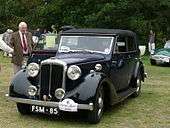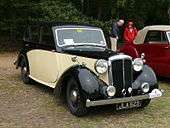Daimler Consort
| Daimler Eighteen DB /18 | |
|---|---|
|
Consort six-light four-door saloon 1952 example | |
| Overview | |
| Manufacturer | The Daimler Company Limited |
| Also called |
Daimler Eighteen (1939–1950) Daimler 2½ litre [1] (1939–1950) Daimler Consort (1949–1953) |
| Production | 1939–1953 |
| Body and chassis | |
| Class | Executive car (E) |
| Body style |
four-door saloon numerous coachbuilt versions, standard catalogued models by Daimler subsidiaries Hooper (formal) and Barker (drophead coupés), others as arranged with coachbuilder by customer [2] |
| Layout | FR layout |
| Powertrain | |
| Engine | 2,522 cc 6-cylinder in-line ohv [2] |
| Transmission |
4-speed preselective self-changing gearbox and Fluid Flywheel an open propellor shaft and underhung worm-driven axle, hypoid bevel from June 1950 Overdrive on Special Sports |
| Dimensions | |
| Wheelbase | 114 in (2,900 mm)[2] |
| Length |
180 in (4,600 mm) (2½-litre)[3] 180 in (4,600 mm) (Consort)[2] |
| Width | 65 in (1,700 mm)[3] |
| Height | 63 in (1,600 mm) [3] |
| Chronology | |
| Predecessor | Daimler New Fifteen |
| Successor |
Daimler Conquest whole new smaller vehicle Daimler Regency same chassis, bigger engine |
| Daimler Eighteen 2½-litre engine | |
|---|---|
| Overview | |
| Manufacturer | The Daimler Company |
| Production | September 1938 - 1953 introduced in Daimler Fifteen |
| Combustion chamber | |
| Configuration | 6-cylinder in-line |
| Displacement | 2,522 cubic centimetres (154 cu in) |
| Cylinder bore | 69.6 mm (2.74 in) |
| Piston stroke | 110.49 mm (4.350 in) |
| Cylinder block alloy | cast iron, aluminium alloy pistons |
| Cylinder head alloy | detachable |
| Valvetrain | OHV, pushrod cam-in-block (and from 1946) valves canted 15 degrees in special combustion chambers |
| Compression ratio | 7:1 |
| Combustion | |
| Fuel system |
Horizontal S.U. carburettor AC mechanical fuel pump dual carburettors on Special Sports |
| Fuel type | petrol |
| Oil system | gear pump 40 lb pressure |
| Cooling system | water-cooled thermostatically controlled, centrifugal pump and 4-blade fan |
| Output | |
| Power output |
from 1946 70 bhp (52 kW; 71 PS) @ 4000 rpm. Tax rating 18.02 hp |
| Chronology | |
| Predecessor | Daimler Fifteen 2.2-litre |
| Successor | Daimler Conquest 2½-litre |
The Daimler Eighteen or Daimler DB18 is an automobile which was produced by Daimler from 1939 to 1953. It is a 2½-litre version of the preceding 2.2-litre New Fifteen introduced in 1937.
Using the engine developed for the Daimler Scout Car,[4] it was offered to customers from 1939 as a six-cylinder chassis on which Daimler and various British coach builders offered a range of bodies including drop-head coupes.[3]
Development
The model was introduced immediately before the start of the World War II, during which the company was compelled to concentrated on the manufacture of military vehicles. Therefore, most DB18s were produced after 1945.
To contemporaries the model was generally known as the Daimler 2½-litre until Daimler adopted the North American habit of giving their cars names (although not on any badgework), and a slightly updated version of the car was introduced in October 1948 at the London Motor Show, "principally for export" and branded as the Daimler Consort.[5] The updates included the integration of the firewall into the body rather than it being part of the chassis, a move from rod operated mechanical brakes to a Girling-Bendix hydraulic front and rod operated rear system, incorporating the head lights into the front guards, and providing a badge plate behind the front bumper with a more curved radiator grille.
Specification
The car used a 2,522 cc in-line six-cylinder, pushrod ohv engine fed by a single SU carburetter.[3] Throughout its life, 70 brake horsepower (52 kW) was claimed, though a change in the gearing in 1950 was marked by an increase in maximum speed from 76 miles per hour (122 km/h) to 82 miles per hour (132 km/h) for the saloon, while the acceleration time from 0 – 50 miles per hour (80 km/h) improved from 17.9 to 16.9 seconds.[2] By the standards of the time the car was brisker than it looked.[3]
The car was supplied with the Daimler Fluid Flywheel coupled to a 4-speed Wilson Pre-selector gearbox. The independent front suspension used coil springs, while the back axle was suspended using a traditional semi-elliptical set-up.[3] The chassis was "underslung" at the rear with the main chassis members passing below the rear axle. In mid-1950 the restricted ground clearance was improved by the adoption of a conventional hypoid bevel drive to the rear axle replacing the traditional Daimler underslung worm drive which had hampered sales outside Britain.[6]
Coachwork
Although offered originally as a chassis only model, post-war the most common version was a four-door saloon which Daimler themselves produced. The interior was fitted out with traditional “good taste” using mat leather and polished wood fillets.[3] By the early 1950s, this coachwork was beginning to look unfashionably upright and “severe yet dignified”.[3]
In 1939, Winston Churchill commissioned Carlton Carriage Co to build a drophead coupe on a DB18 chassis, chassis No.49531. Never used until post-World War II, he used it during election campaigns in the later 1940s.[7]
Production
Approximately 1,000 DB18s and 25 DB18 Special Sports were produced to 1940.[8] In addition 3,355 DB18s, 608 DB18 Sports Specials and 4,250 DB18 Consorts were built in the post-war years.[9]
The Consort became a popular car among the wealthy in India. All together over 100 cars were ordered mainly by the Maharaja's in India and a further dozen were ordered by Royalty in Ceylon and Burma.
Gallery
- Some other bodies on the same 2½ litre Eighteen chassis
 Tickford 4-door tourer by Salmons
Tickford 4-door tourer by Salmons
1940 Dolphin 4-dr sports saloon by Charlesworth
Dolphin 4-dr sports saloon by Charlesworth
1940 Eighteen
Eighteen
six-light saloon
1947 Tickford drophead coupé by Salmons
Tickford drophead coupé by Salmons
1950
- Empress saloon body by Hooper
1951  Special Sports
Special Sports
drophead coupé by Barker
1952
References
- ↑ Daimler 2½ litre sales brochure, picasaweb.google.com Retrieved 26 July 2016
- 1 2 3 4 5 Culshaw; Horrobin (1974). Complete Catalogue of British Cars. London: Macmillan. ISBN 0-333-16689-2.
- 1 2 3 4 5 6 7 8 9 "Second Hand car guide supplement". Practical Motorist. 6 (68): 768–769. April 1960.
- ↑ Douglas-Scott-Montagu, Edward John Barrington & Burgess-Wise, David (1995). "War and Peace". Daimler Century: The full history of Britain's oldest car maker. Foreword by HRH The Duke of Edinburgh. Sparkford, Nr Yeovil, Somerset, UK: Patrick Stephens. p. 248. ISBN 1 85260 494 8.
- ↑ "2½-litre Daimler Consort saloon". Autocar. September 9, 1949.
- ↑ Display advertisement, The Times, Thursday, Jun 15, 1950; pg. 8; Issue 51718
- ↑ Chris Knapman (9 Nov 2010). "Winston Churchill Daimler to be auctioned". Daily Telegraph. Retrieved 1 May 2013.
- ↑ Michael Sedgwick & Mark Gillies, A-Z of Cars of the 1930s, Haymarket Publishing Ltd, 1989, page 61
- ↑ Michael Sedgwick & Mark Gillies, A-Z of Cars 1945-1970, Haymarket Publishing Ltd, 1986, page 48
This entry includes statistical information from the German Wikipedia concerning the Daimler Motor Company.
External links
| Wikimedia Commons has media related to Daimler Eighteen. |
| « previous — Daimler road car timeline, 1945–1979 — next » | |||||||||||||||||||||||||||||||||||||||
|---|---|---|---|---|---|---|---|---|---|---|---|---|---|---|---|---|---|---|---|---|---|---|---|---|---|---|---|---|---|---|---|---|---|---|---|---|---|---|---|
| Type | 1940s | 1950s | 1960s | 1970s | |||||||||||||||||||||||||||||||||||
| 5 | 6 | 7 | 8 | 9 | 0 | 1 | 2 | 3 | 4 | 5 | 6 | 7 | 8 | 9 | 0 | 1 | 2 | 3 | 4 | 5 | 6 | 7 | 8 | 9 | 0 | 1 | 2 | 3 | 4 | 5 | 6 | 7 | 8 | 9 | |||||
| Sports car | Conquest Roadster | Conquest 3–seat dhc | SP250 | ||||||||||||||||||||||||||||||||||||
| Sports saloon | Special Sports | Conquest Century | |||||||||||||||||||||||||||||||||||||
| Sportsman | |||||||||||||||||||||||||||||||||||||||
| Saloon | DB18 | Conquest | 2.5 V8 | V8-250 | |||||||||||||||||||||||||||||||||||
| Consort | |||||||||||||||||||||||||||||||||||||||
| Large saloon | DE 27 | Regency | Regency Mk II | One-O-Four | Majestic | Sovereign 420 | Sovereign XJ6 Mk I | Sovereign XJ6 Mk II | |||||||||||||||||||||||||||||||
| Regency 4½ Litre (DF 304) | Majestic Major | Double Six Mk I | Double Six Mk II | ||||||||||||||||||||||||||||||||||||
| Flagship | DE 27 | Regina | DK400 | DR450 | DS420 | ||||||||||||||||||||||||||||||||||
| DE 36 | |||||||||||||||||||||||||||||||||||||||
| Ownership | Birmingham Small Arms | Jaguar Cars | BMH | British Leyland | |||||||||||||||||||||||||||||||||||